
Dear Members:
Change. It's amazing how much resistance there is to change in this world. In some cases, people resist change because it takes them out of their comfort zone. This is understandable. But getting out of our comfort zone often brings innovation, progress, and advancement. In other cases, the resistance is based on personal gain, greed, or ignorance.
Last month a UK mother and father were arrested and jailed because they removed their five-year-old son from the hospital in order to take him out of the country to be treated with proton therapy. Little Ashya King has stage 4 medulloblastoma, a malignant brain tumor, and had an estimated four months to live if untreated. Local physicians told the parents their son's brain tumor could be treated with conventional radiation, although there was a good chance the treatment could leave him brain damaged and possibly blind. They further advised the parents that proton therapy was no better than what they had to offer. Change!

The story gained worldwide attention after the Kings were jailed. As a result of pressure from around the world, the charges were dropped; Brett and Naghmeh King were released from jail; and little Ashya was referred for proton therapy outside the UK. Let's hope and pray Ashya does well with his proton treatment.
One couple who came to the Kings' support in the UK were Paul and Rosalie Barnes, parents of Alex Barnes. Alex was diagnosed with brain cancer and was given an 80 percent chance of dying. Proton therapy in the U.S. saved his life. Today, six years later, Alex is cancer free, riding his bike, and playing football just like the other ten-year-old boys in his neighborhood.
Interestingly, the British health organization, NHS, announced last year they are planning to build two proton centers in the UK. I suspect their position on treating pediatric brain tumors with protons will change in the future.
Resistance to change takes many forms. Science substantiates the benefits of proton therapy based on the proven fact that higher doses can be delivered to the target with significantly less radiation deposited on healthy tissue. This can improve cure rates, reduce chances of side effects, and minimize the possibility of secondary malignancies later. Yet, in the absence of randomized clinical trials proving all this, some medical insurers are reluctant to pay the higher initial cost of proton therapy. They take this position even though clinical trials are underway to a" compare proton therapy to IMRT and, b" shorten treatment times and reduce initial treatment costs.
BOB members respond. Last month we sent out an urgent email request to BOB members to respond to a proposed change in proton reimbursement for prostate cancer by Health Care Services Corporation "HCSC". HCSC is the largest customer-owned health insurance company in the U.S. Their subsidiaries include Blue Cross Blue Shield of Illinois, Montana, New Mexico, Oklahoma, and Texas.
If BCBS in these five states stops reimbursing for prostate cancer proton therapy treatment, others are sure to follow, and this could prevent thousands of men from receiving proton therapy for prostate cancer in the future.
Thankfully, hundreds"if not thousands"of our members responded. Many copied Deb and me on their responses, all of which were thoughtful and compelling. Individual proton centers also responded, as did the U.S. Department of Health and Human Services through the National Cancer Institute, urging HCSC to continue covering proton therapy treatment for prostate cancer.
At this writing, we do not know if our efforts have persuaded HCSC to change direction, but they cannot ignore this overwhelming response to their proposed policy change.
I would like to thank our members for rallying together and supporting this important cause. There is strength in numbers, and our 7,200 members have a voice which was certainly heard on this critically important issue.
Bob Marckini
As always, we welcome your feedback and suggestions for improving the BOB Tales. Just sent an email to Deb Hickey at [email protected].
To print the BOB Tales newsletter or view the newsletter with a larger font size, click here for the PDF file.
in this issue
- Proton center closes
- Discover Magazine: Proton article angers members
- Study: Proton therapy less costly than IMRT?
- Study: Prostate tests would cut deaths
- Members respond in large numbers to HCSC reimbursement change
- Proton therapy saves one member's life … twice
- BOB member pens book"all proceeds go to pediatric proton patients
- BOB PowerPoint presentation updated
- Another $100k gift by one member's foundation
- Does sugar "feed" cancer?
- Aspirin vs. cancer
membership

We have 7,210 members; we added 60 new members last month, including our first member treated at the new proton center in Prague, Czech Republic. We have members from all US states and 35 countries representing all operating proton centers in the U.S. as well as four proton centers in Europe and Asia.
news report
Indiana University Health Proton Center "Formerly MPRI" to Close
Indiana University Health Proton Therapy Institute "IUHPTI" announced on August 22, 2014 that they would be closing by January 1, 2015. An outside review committee completed a study and made this recommendation which IU Health accepted.
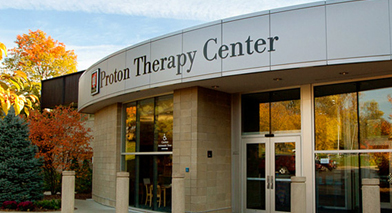
IUHPTI was the third proton center to open in the U.S. and the first one in the Midwest. They have treated 2,000 patients since opening in 2004. Many of these former patients are BOB members who have told us of their positive treatment experiences at IU. Several have written to us expressing their sadness at the closing. Among the reasons for the closure mentioned in their press release are the following:
Increased Costs and Declining Revenue
New proton centers are opening in the U.S.; insurance reimbursement rates are falling; and the facility has been operating at a deficit for most of its existence.
Aging Equipment
The proton center was built around a cyclotron originally built in 1976 for their research facility. The cost of maintenance and upgrades is prohibitive. Consideration had been given to replacing the 38-year-old cyclotron, but that, too, would be cost prohibitive.
Lack of Research Revenue
Non-clinical research revenues are minimal and there are no prospects for new research contracts because of the aging equipment and technology.
Other reasons were also given. The press release closed with the following statement, "The committee came to the conclusion that with the many alternative cancer treatment options available to patients, along with the cost to upgrade and maintain the facility, continuing the operation in today's healthcare environment simply is not viable."
Read the entire press release on the IUHPTC closure.
New Proton Center Planned for Singapore
Singapore Institute of Advanced Medicine Holdings PTE Ltd has announced they will be constructing a new proton treatment center in Biopolis Singapore using ProNova technology. Biopolis is an international research and development center for biomedical sciences. Many of the largest medical technology companies in the world have established research centers there, with more than 2,000 scientists carrying on research programs on the Biopolis campus.
The new proton center will have two rotating gantries for treating patients and a fixed beam room for research. It will have active beam "pencil beam" scanning, 3D imaging, and will cost more than $100 million. Their press release stated that their new proton treatment center "will be a major step in redefining the future of cancer treatment."
A timetable for the project has not yet been announced.
Discover Magazine: Precision vs. Profits
Dozens of members contacted us after the October issue of Discover Magazine hit the stands. In it was an article titled, "Precision vs. Profits." The article touts the technology of proton therapy as advanced, but beneficial to treating only select cancers. It singles out treating prostate cancer as wasteful because it costs more money than treating with conventional radiation and has not been proven to be better.
In supporting their hypothesis, the article mentioned one study which examined Medicare billing records and followed patients for one to two years. This study concluded that proton therapy was no better than IMRT for treating prostate cancer. They ignored all the other studies and surveys that show the benefits of proton therapy for treating prostate cancer.
Ironically, the article spends considerable time explaining why protons are superior to photons "x-rays" in treating tumors "brain, spine, pediatric tumors" that are close to critical structures, yet criticizes the use of protons for treating the prostate"which is surrounded by critical structures.
One BOB Member's Opinion
One of our members made the following points in an email to us:
I take great exception to the article's comments about side effects. My experience matches very closely with those documented in Bob Marckini's book "including, I might add, my older brother's experience with surgical removal of the prostate".
I have talked with a number of folks who have had prostate cancer. These men represent a number of treatments "surgery, radioactive seeds, regular photon radiation, proton radiation, and HIFU". From my 'listening' process, the only universally happy group of men were those who had proton therapy. I am amazed at the consistent lack of significant side effects from those men who had proton therapy. And my personal experience matches very closely with these men. I also find it curious that, prior to my own treatment, the only men who seemed to advocate for a treatment were the men I met who had undergone proton therapy. Even my brother did not tell me to be sure and have my prostate surgically removed.
In short, I believe the article was very deficient in facts that would cause me to second guess my proton therapy.
The article also makes it sound like 'greedy' proton centers have somehow duped men into getting proton therapy when cheaper equivalent treatments are available. I actually believe it is the greedy insurance companies that are trying to push the cheaper treatments that are not equivalent.
The article is certainly skimpy on facts. If you read the title page, the clear implication is that proton therapy saves some cancer patients "the young kids with tough to reach cancers" and not the patients that receive the marketing "the proton patients". That cute title page may get folks to read the article, but the title page is blatantly false.
Maybe Benjamin Franklin was right when he said, "Believe none of what you hear, and only half of what you see."
Proton Therapy Less Costly than IMRT for Treating Certain Cancers
A study conducted at MD Anderson Cancer Center concluded that proton therapy is actually less costly for treating oral cavity, larynx, and brain stem cancers. The tool used to compare the treatments is called Time-Driven Activity-Based Costing, or TDABC.
Current costing methodology assumes that higher reimbursement automatically indicates higher cost of treatment. TDABC looks at costs for all resources consumed in providing a clinical service, not just the reimbursed cost of the initial treatment.
In this study, researchers compared IMPT and IMRT in treating these oral cavity, larynx, and brain stem cancers. IMPT is Intensity Modulated Proton Therapy, also known as active beam scanning or pencil beam proton therapy. And while the cost of each daily IMPT treatment in the study was 2.8 times higher than for IMRT, the total cost of treatment was actually lower with proton treatment using the TDABC tool.
Read the full article "Defining the Value of Proton Therapy" on printed page 22 of this report.
Study: Prostate Tests Would Cut Deaths

A randomized study was conducted on 162,000 men aged 50 to 74 from eight European countries: Belgium, Finland, France, Italy, the Netherlands, Spain, Sweden, and Switzerland. The study concluded that screening men for prostate cancer could reduce deaths from the disease by more than 20 percent, despite doubts that have been expressed about the PSA screening test. During the 13-year follow-up period, the risk of death was 21 percent lower in men who were screened than in those who were not.
Lead researcher, Professor Fritz Schroder, of Erasmus University Medical Center in the Netherlands, said, "PSA screening delivers a substantial reduction in prostate cancer deaths, similar or greater than that reported in screening for breast cancer."
The study published in The Lancet Medical Journal also pointed out that a danger associated with prostate cancer diagnosis is over-treating very early stage disease, often leaving men with significant quality-of-life changing side effects like impotence and incontinence.
Despite these significant results, researchers said, "The time for population-based screening has not arrived." "Really?" They go on to say "Further research is urgently needed on ways to reduce over-diagnosis, preferably by avoiding unnecessary biopsy procedures and reducing the very large number of men who must be screened, biopsied and treated to help only a few patients."
Read an article on this study from the Irish Times.
events
National Proton Conference | 2015

Registration is now open for the 3rd Annual National Proton Conference"Creating a Better Future for Cancer Patients Worldwide. The event takes place in Washington, D.C., March 30 through April 2, 2015. More information will follow.
Recap: BOB Reunion near Boise, ID
About 40 people attended the Eagle, Idaho BOB reunion this past August"some traveled from 150 miles away. LLUH Director of Special Services, Dr. Lynn Martell, shared an exciting report on Vision 2020, reported on new proton therapy clinical trials at LLUMC, and shared a couple of DVDs including a short film, "Surgeons of Hope," which portrays a young boy, Holman Padilla Velasquez, and his mother, Carmen. It is discovered by local doctors in his country of Nicaragua, that Holman has a heart murmur and needs open-heart surgery. However, in Nicaragua, even if children survive surgery, they run a high risk of dying from infection in the intensive care unit afterward. With no money to explore foreign options, Carmen reluctantly brings her son to the local hospital. Upon checking in, they discover that a pediatric heart surgery team from Loma Linda University will be at the hospital for one week to treat patients and train the staff as part of the Loma Linda 360° Surgeons of Hope project. At least 100 children and families cram into the waiting area where just ten will be chosen for treatment. Holman was one of the lucky ones.
The film also portrays a young girl at the Nicaraguan hospital during LLU's visit. She is malnourished and near death. We encourage all to watch this captivating film.
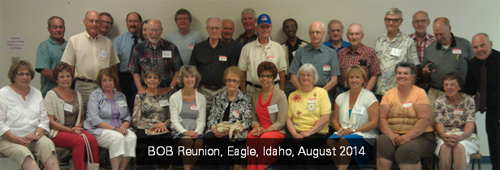
spotlight on members
Members Respond in Large Numbers to HCSC Reimbursement Change
As mentioned in our opening memo, our group once again rallied to the cause and responded in large numbers to the proposed reimbursement change by Health Care Services Corporation "HCSC". Their proposed policy change would effectively terminate BCBS reimbursement for prostate cancer proton therapy in Illinois, Montana, New Mexico, Oklahoma, and Texas beginning on January 1, 2015.
We don't know the exact number of responses by our membership, but based on the emails we received; it was likely well into the thousands. Here is one example of the thoughtful and constructive ways in which our members responded:
I am and have been a Blue Cross Blue Shield of Illinois subscriber for many years. I disagree with the proposed policy change regarding charged-particle "proton and helium ion" radiation therapy.
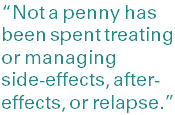
Until my recent retirement, I was executive director of the American Society for Blood and Marrow Transplantation "the association of hematopoietic stem cell transplant physicians and investigators", chief executive officer of the Foundation for the Accreditation of Cellular Therapy "accrediting agency for cell transplant programs in universities and medical centers around the world", and managing director of the International Netcord Foundation "association of umbilical cord blood banks".
In addition to a professional familiarity with cancer, I am a cancer survivor.
My chance of having urinary incontinence today should be about 65-70 percent. My likelihood of being impotent ought to be 30-35 percent. But I avoided those odds, taking them to nearly zero, by my decision to bypass surgery and conventional radiation therapies for my prostate cancer. I experienced none of those conditions, or their costs, and I am cancer-free because I received state-of-the-art conformal proton beam therapy.
A biopsy revealed my prostate cancer at age 63. My course of proton therapy was reimbursed by BCBS of Illinois. I experienced no side effects of any kind either during or after treatment.
No question, proton beam therapy was more expensive than conventional alternatives. But it was a one-time cost, and today"five years later"I can refer to my cancer in the past tense. Not a penny has been spent treating or managing side-effects, after-effects or relapse. More important, my quality of life has not been diminished in any way.
My post-therapy experience is the same as everyone I know who has had proton beam therapy for prostate cancer. On the other hand, my experience contrasts greatly with what I've been told by friends and acquaintances who have had conventional surgical or radiation therapies: woeful testimony about their serious complications, wearing adult diapers, impaired intimacy, and ongoing costs for disease management and follow-up treatments.
My understanding is that Health Care Services Corporation is proposing to change its policy and stop paying for proton therapy for prostate cancer beginning on January 1, 2015. I can testify from personal experience that denying reimbursement would be a false economy. It will assure ongoing costs for treating and managing chronic diseases and injuries caused by traditional therapies, and it will condemn many prostate cancer patients to a miserable quality of life.
If you want any additional information about my experience with prostate cancer and a patient's perspective on proton beam therapy, please don't hesitate to contact me.
"Alan Leahigh
Once again, thank you to Alan Leahigh and all the other BOB members who responded. We can make a difference. We will notify you when we learn more about HCSC's plans.
A New Cancer Challenge for One BOB Member:
How Proton Therapy Saved His Life Again
Shortly after last month's newsletter was issued, we received an email from BOB member, Bob Daum "Lancaster, MA". He had an interesting story to tell us. Bob was treated with proton therapy for his prostate cancer back in 2010. He had tremendous results and left feeling "thankful to God" for leading him to Loma Linda for treatment.
Bob told us that a statement in last month's newsletter prompted him to tell us more about his health in recent years. That statement was: "…studies of nasal cavity and paranasal sinus tumors, they found disease-free survival to be significantly higher at five years for patients receiving proton therapy than for patients receiving IMRT."
A New Cancer Challenge
Bob's ENT specialist had been advising him for a couple of years about a deviated septum in his nose. He said he could fix it with out-patient surgery. Bob put this off for a number of months before he finally went in for the routine "repair job." During the procedure, a tumor was "accidentally discovered" in March of 2014. The doctor had it biopsied and later confirmed his suspicions. The diagnosis was: NK/T-cell lymphoma tumor"nasal type.
Bob's doctor said he had seen just ten or eleven cases of this in 25 years and "it is quite uncommon." Therefore, he suggested Bob set up an appointment with a local oncologist and lymphoma specialist. Bob also saw a head and neck oncologist who ordered a PET scan and MRI tests. Later, the oncologist shared the findings of the scans and advised Bob to consult with a local cancer center. Two weeks later, Bob visited the cancer center and his new doctor confirmed what the other doctors had told him.
Radiation Therapy"Primary Treatment
Bob's doctor at the cancer center told him that the primary tool of attack for this type of cancer is radiation, followed by three rounds of chemotherapy. Bob said to his doctor, "If we are talking about radiation on my face, I prefer the use of the proton beam." The doctor replied, "That is not a good idea because of the need to draw a specific target area and this lymphoma can put out fingers that go beyond such an area." Bob thought to himself, this place doesn't offer proton therapy.
Later, Bob met with a radiation oncologist anyway. She was "most impressive in her level of grasping the problem and the best solution," and did a "masterful job of describing the great advantages and the approach of IMRT." She also described the side effects and minimized the impact they would most likely have. "She almost had me sold," Bob told us. But, having read the BOB Tales newsletter for years about the advantages of proton over IMRT, Bob decided not to do it. "I told my doctor that if my face was to receive radiation, I prefer proton and if Loma Linda could do it, that was where I'd be going."
Headed Back to Loma Linda
"I figured the possibility of Loma Linda taking my case was slim because of how rare my cancer was," Bob told us. "So, I immediately called Dr. Lynn Martell; sent him the lab reports and three disks: The PET scan, the MRI results, and the CAT scan of my sinuses." Lynn sent the information to the head of the LLUMC Cancer Center, and soon thereafter, Bob's records were given to one of the radiation oncologists, interestingly, the same doctor who had treated Bob's prostate cancer four years prior. The doctor informed Bob that he would meet with a head and neck specialist that afternoon and get back to him.
Bob was quickly informed that LLUMC would take his case. By that evening, Bob and his wife, Mary Jo, rented an apartment, secured a car rental, and bought their airfare.
"I went again to Loma Linda for 28 proton treatments," Bob said. "The doctors were really into my case and had an amazing level of knowledge and authority. They went into great detail, explaining the parameters they considered in designing the proton treatment plan"the dosage and rate of administration and the pathway of proton travel." Bob's doctors mentioned they would avoid damaging the optical nerve "the tumor was pictured clearly as a vertical mass right between Bob's eyes" and most likely be able to avoid various side effects that he'd been concerned about.
Blessed with Great News
"The prayers of dozens of family and friends for God's healing touch on my lymphoma cancer tumor were answered," Bob said. "We are praising the Lord big time."
A month after treatment, an MRI showed that Bob's tumor was completely absent. Bob's local oncologist told him that the report from LLUMC looked very good and that his face looked "extra-good" as compared to what he is accustomed to seeing when a patient has had IMRT radiation for such a tumor.
Bob told us, "I never had any indication of a tumor in my nose. After being treated again at LLUMC, I sensed the very presence of my personal Savior, Jesus Christ."
Member Pens Book about His Prostate Cancer Journey:
All Proceeds Support Pediatric Proton Patients

BOB member, Don Denton "Townsend, TN" was treated with proton therapy in 2011. Today, he is enjoying life to the fullest. When Don was diagnosed, he refused surgery; stumbled onto proton therapy; struggled to get insurance coverage; and ultimately had a wonderful treatment experience. His book is about the role his faith played in his prostate cancer journey, and how his faith was strengthened as a result of his experience. In the book, Don enumerates all the reasons he's glad he had cancer. "Having cancer," he says, "proved to be one of the most positive experiences of my life, but only because of proton therapy."
Here is Don's story in his own words:
When I was diagnosed 3 ½ years ago, my doctor highly recommended his specialty"surgery. He told me that if I followed his advice, I'd likely have some quality of life issues, a 65 percent chance of surviving at least ten more years, and a high probability of a recurrence. Ironically he called surgery the 'Gold Standard.'
I wasn't impressed, so I searched for alternatives. I read a half-dozen books and hundreds of articles; exhaustively browsed the Internet; and networked with dozens of people. Proton therapy never came up. Fortunately, I later met two gentlemen who told me they had been cured of their cancers with what I now call "the best kept secret in medicine." Quite frankly, their words sounded too good to be true, but that encounter literally changed my life.
Proton therapy did for me what conventional treatment methods could not do. Not only did it preserve my life, but it preserved my quality of life. Now, I don't feel like I ever had cancer. I give credit to God for making proton therapy possible and for leading me to it.
All proton patients I know are evangelistic about proton therapy, and that's great, because word-of-mouth is the primary way for people to learn about it. My wife, Sulynne, and I have felt an ethical responsibility to tell others about proton therapy.
I was inspired to write my book while watching a gorgeous sunrise last June over the Sea of Galilee, the place where Jesus performed the great miracle of Calming the Storm, which became the title of my book. My book is different from others in that it approaches the topic of prostate cancer from a spiritual perspective.
I feel so blessed to have experienced healing via proton therapy that 100 percent of the proceeds from the sale of Calming the Storm are being donated to helping pediatric patients whose families cannot afford proton therapy.
Calming the Storm is a great spiritual resource to educate and encourage people about proton therapy, and its sale provides a means to support children with cancer.
Don's book is available for purchase online.
BOB PowerPoint Presentation Updated
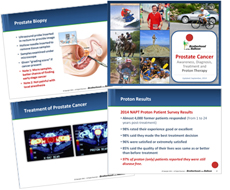
The BOB PowerPoint presentation "62 slides, also available as a PDF" is available to all members. It is intended to 1" educate people on prostate cancer awareness, detection, and prevention; 2" help people understand the prostate cancer diagnosis; 3" provide an overview of the major treatment options; 4" provide information about proton therapy; and 5" encourage people to become educated and proactive in the treatment decision-making process. Detailed speaker's notes are included.
We encourage members to use the presentation to help to spread the word about proton therapy and present at prostate cancer support group meetings, Lions Clubs, Kiwanis Clubs, church meetings, and neighborhood gatherings. Others have used the presentation as an aid in educating friends and family members about proton therapy. We encourage members to make the presentation their own"delete, add, and edit slides depending on your story and the audience.
Member Gary Dahlen "Manitou Springs, CO" says the BOB PowerPoint helped him to get "salient points across" when trying to educate friends about proton therapy. "With the aid of the PPT, I successfully convinced ten people to be treated with proton therapy for their prostate cancer," he told us. Another member used the presentation to present to a handful of old classmates. "I printed and selected just a few slides to use as a hand-out after my presentation," he said.
We recently updated the presentation to include new information on proton therapy, including the results of the 2014 National Association for Proton Therapy "NAPT" survey. If you have any questions or would like to receive the BOB PowerPoint presentation, just send an email to: [email protected].
Number of BOB Facebook Fans Exceeds 555
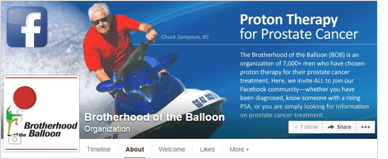
Facebook offers us the opportunity to interact with an extraordinarily expansive universe of people"people beyond our community of 7,200 members. By connecting with friends on Facebook and thus connecting with their Facebook friends and their Facebook friends "and so on", we are leveraging our proton message exponentially. For this very important reason, we ask that if you are not on Facebook, please join and become a BOB fan. If you are already on Facebook, visit the BOB page and click the "like" button to become a BOB fan. Encourage your friends to do the same. Help us reach 600 fans by year end!
Loma Linda University Medical Center's Proton Treatment Center Joins Facebook
Loma Linda University Medical Center's Proton Therapy Treatment Center now has its own Facebook page. The first post links to a comprehensive article that may answer every question you've ever had about proton therapy: "Proton Therapy: What We Have Learned in Our First Quarter-Century," by Dr. Jerry Slater, MD.
Note: You do not need to be a Facebook member to visit any of the pages mentioned in this article.
Members Celebrate Milestone Birthdays
Charlie Einseidler: 101

Charlie Einsiedler was treated 15 years ago at Loma Linda and he's doing great! He walks every day, works on technical projects to keep his mind active, and he reads the BOB Tales cover-to-cover every month. "It's my highest priority reading," he says. Charlie is a big fan of proton therapy and he loves to talk about proton technology and the Bragg peak. Charlie turned 101 years old on September 29th!
Charlie told us, "I'm feeling great, but I haven't got nearly the energy I did when I was 99."
Clyde Marsh: 80
Clyde Marsh recently celebrated his 80th birthday. Clyde was treated at Loma Linda in 2007. Since then, he and his wife, Sylvia, have dedicated themselves to keeping the Tuesday night potluck dinners running smoothly. The patient-run dinners take place every week at the Loma Linda Springs apartment community "where many patients and their families stay throughout treatment". Clyde's overall goal is to help patients "step back from their medical situation" and take part in an exciting night of good fellowship. The group also collects money to donate to proton research. Clyde's "proton family" "including current patients" filled a local restaurant to celebrate his special day. Clyde described the evening as "a typical proton scene"laughter, smiles, and a lot of hugging."

making a difference by giving back
Sequoia Foundation Contributes $100,000 to Vision 2020
One of our members is the founder of the Sequoia Foundation, an organization that works with public agencies in the U.S. and abroad to protect human health and the environment. The Sequoia Foundation has previously offered a challenge gift to match any contribution of $1,000 or more to the Robert J. Marckini Endowed Chair at Loma Linda University Health, up to a total of $25,000.
After reading the article in last month's BOB Tales about Vision 2020 at Loma Linda, this member contacted us and announced the Foundation would contribute $100,000!
We asked permission to mention his name and gift in our BOB Tales newsletter. He indicated he prefers to remain anonymous, but said the following:
I'm very thankful to Loma Linda. They were able to design a special proton treatment protocol for me because of my two hip replacements. And through this gift, I also want to acknowledge the contributions Bob Marckini has made, first with his research and book, and afterwards as a strong voice supporting the value of the proton approach.
We are very grateful to the Sequoia Foundation and this member for his generosity, for supporting the Robert J. Marckini Chair, and for another significant gift to LLUH.
Matching Gift Promises to Double Yours
As mentioned above, the Sequoia Foundation for Achievement in Culture and Education is encouraging fellow BOB members to match a $25,000 challenge grant. The foundation will match gifts of $1,000 or more to the Robert J. Marckini Chair, up to a total of $25,000, until December 31, 2014. Please consider taking this opportunity to double the impact of your gift!
If you have questions about the various ways to support proton research efforts, please contact the Office of Philanthropy at LLUH at 909-558-3284 or send an email to Aaron Laudenslager at [email protected].
To donate by check, make it out to "LLUMC Proton," specify Robert J. Marckini Chair in the memo, and mail it to: Loma Linda University Medical Center, Office of Philanthropy, P.O. Box 2000, Loma Linda, CA 92354.
Or, donate online. Specify Robert J. Marckini Chair under "Designations." Both credit and debit cards are accepted.
For more information on how to support the James M. Slater, MD, Proton Treatment and Research Center through an estate gift, contact Todd Mekelburg at the Office of Planned Giving by phone at 909-558-4553, visit the website at llulegacy.org, or email [email protected] .
health
Does Sugar "Feed" Cancer?
You've probably heard this statement before: Sugar feeds cancer. As a result of the wide circulation of this statement in the media, many cancer patients have removed sugar completely from their diets, even eliminating healthy foods such as fruits.
Is the Statement True?
There is no conclusive research to prove that sugar makes cancerous cells grow and metastasize. Avoiding foods with processed sugar "candy, cakes, soda, etc." is a good idea in general, but eliminating foods with natural sugar won't stop cancer cells from dividing.
In fact, every cell in your body needs blood sugar in the form of glucose for energy. Most associate the term "sugar" with the white sugar we put in coffee. When talking about biological processes, sugar is a general term for dozens of vital chemical structures in our bodies.
Be Aware of Hidden Sugars
In addition to cookies, cakes, and other sweets, "bad sugar" is found in pasta sauce, salad dressing, and canned vegetables. In addition to looking for "sugar" on food labels, also be aware of other names for sugar: fructose, lactose, sucrose, maltose, glucose, and dextrose.
Natural sugars include molasses, agave nectar, honey, and maple syrup. They contain beneficial antioxidants but those, too, should be consumed in moderation.
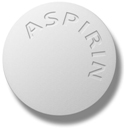
Aspirin vs. Cancer
Aspirin has long been known to have cancer prevention effects, but it has not been widely used for this because of concerns about potential harm. Experts have now declared, for the first time, that the benefits of taking aspirin to prevent some types of cancer outweigh the potential harms. This conclusion comes from an article recently published online in the Annals of Oncology.
A study, conducted at the Center for Cancer Prevention at Queen Mary University, London, England, reported that, "Accumulating evidence supports an effect of aspirin in reducing overall cancer incidence and mortality in the general population."
"Whilst there are some serious side effects that can't be ignored, taking aspirin daily looks to be the most important thing we can do to reduce cancer after stopping smoking and reducing obesity, and will probably be much easier to implement," said researcher, Jack Cuzick, PhD.
"Our study shows that if everyone aged between 50 and 65 started taking aspirin daily for at least 10 years, there would be a 9 percent reduction in the number of cancers, strokes, and heart attacks overall in men, and around 7 percent in women," said Dr. Cuzick. "The total number of deaths from any cause would also be lower, by about 4 percent over a 20-year period. The benefits of aspirin use would be most visible in the reduction in deaths due to cancer."
Researchers found the effects of aspirin on cancer are not apparent until at least three years after the start of use. The study concluded that "Prophylactic aspirin use for a minimum of five years at doses between 75 and 325 mg/day appears to have favorable benefit-harm profile; longer use is likely to have greater benefits. Further research is needed to determine the optimum dose and duration of use."
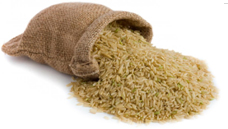
More on Foods to Reduce
Blood Pressure
A diet high in vegetable protein"not animal protein"is key if you're trying to lower your blood pressure. Foods like broccoli, brown rice, and baked beans are great sources of blood-pressure-friendly protein.
Researchers suspect that the amino acids in vegetables may simply be kinder, somehow, to blood pressure than the amino acids in animal protein, and the magnesium and other nutrients found in vegetables may enhance the blood-pressure-friendly effects by interacting synergistically with the amino acids.
Before you grab your steak knife, consider other healthy foods rich with protein like nuts, seeds, whole grains, and soy.
Do Bananas Boost Your Immune System?
Though you can't quite "boost" your immune system because it's complex and depends on a constant and balanced level of energy and nutrition, according to Harvard Health Publications, certain nutrients have distinct roles in maintaining a healthy immune system. Bananas are a good source of vitamins and minerals that can impact the immune response.
One medium-sized banana has 2 percent of the recommended daily intake of five of the 11 nutrients: iron, zinc, vitamin A, selenium, and protein. It also provides larger amounts of four other nutrients essential to a normal immune response.
Series: Top 20 Most Common Health Questions "and Answers"
This summer, we began a series on the top 20 most common health questions "and answers" from Business Insider Magazine. Here is the fourth question on the list:
Do nuts make you fat?
Short answer: No. As much as 75 percent of a nut is fat, but eating fat doesn't necessarily make you fat. The bigger factor leading to weight gain is portion-size. Luckily, nuts are loaded with healthy fats that keep you full. They're also a good source of protein and fiber. One study even found that whole almonds have 20 percent less calories than previously thought because a lot of the fat is excreted from the body.
the book
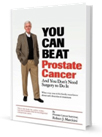
We now have more than 200 reader reviews on Amazon"more than any other book in the top 50! Here is an excerpt from what one reader recently had to say:

The best quality of life post-treatment … "John Campbell
Mr. Marckini's book was just what I needed to make a rational decision concerning the method that would be used to treat my prostate cancer and how protons are used for that. I soon learned that there is more than one way to treat PCa, some of which can leave you wearing Depends for the rest of your life. The individual man really needs to question how he will be treated because he is going to live with the aftermath of that treatment. This book will help immensely with the decision-making process.
Did you find Bob's book helpful?
Please help us to spread the word and educate others about proton therapy. If you found Bob's book to be helpful in making your proton treatment decision, please post a review on Amazon.
Once you are logged into your Amazon account, click here and click the "Create your own review" button. NOTE: Reviews can be just a few sentences"it only takes a few minutes. And, don't forget to rate the book from 1 to 5 stars!
Don't have an Amazon account? No problem. Sign up here"it's free.
Available in Amazon's Kindle format, Barnes & Noble's NOOK Book, and Apple iBook format
Buy the Kindle version now for $9.99.
Don't have a Kindle? No problem"just download the free Kindle reading software for your smart phone or tablet.
Buy the NOOK Book version now for $9.99.
Don’t have a NOOK? No problem. Just download the free NOOK reading app for your Android smart phone, tablet, or iDevice.
Buy the book from the iTunes store for $9.99 for your iPhone, iPad, or iPod Touch in iBook format.
The hard copy version of You Can Beat Prostate Cancer is available online at Amazon, Barnes & Noble and LuLu Press.
Proceeds from book sales are used to help fund BOB efforts and to support proton therapy research.
Ask about our bulk discount for hard copy books for anyone interested in spreading the word about proton therapy: [email protected]
odds & ends

Series: Messing with Your Mind
Here's the last in a series of five optical illusions that really mess with
your mind. Look at the image on the right. Are there two or three?
Series: Did You Know?
- Glass takes one million years to decompose, which means it never wears out and can be recycled an infinite amount of times!
- Gold is the only metal that doesn't rust, even if it's buried in the ground for thousands of years.
- Your tongue is the only muscle in your body that is attached at only one end.
- If you stop getting thirsty, you need to drink more water. When a human body is dehydrated, its thirst mechanism shuts off.
- Zero is the only number that cannot be represented by Roman numerals.
Spread the Word on the Highway
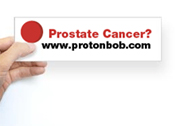
Build awareness about protons with a BOB bumper sticker. Just send $6.00 to Bob Hawley: P.O. Box 45, Mt. Angel, OR 97362 and he'll mail you one. Or, e-mail Bob at
.
All proceeds go to the Robert J. Marckini Endowed Chair for proton therapy research at LLUMC.
on the lighter side
Last Month's Brain Teaser/Riddle
What 5-letter word becomes shorter when you add two letters to it?
Answer: Short. Short becomes shorter when you add "er."
Winner: Member, Paul Gustafson, Ph.D. "Martinez, GA" was the first to submit the correct answer to last month's brain teaser. Paul was treated with proton therapy for his prostate cancer in 2007 and today he tells us he feels "blessed" when he learns of other men who need to wear diapers because of the treatment they chose for their prostate cancer.
Paul recently retired from a local university as a professor of exercise science. He now refers to himself as "a recovering college professor," and is setting up a private practice as a registered kinesiotherapist. His focus will be twofold:
- Provide fitness training for those with Parkinson's disease using non-contact boxing training. This is an approach which has helped to delay, and possibly reverse, the progression of Parkinson's symptoms.
- Provide a non-medical approach to pain relief without the use of medication, manipulation, or surgery.
Paul completed a bicycle trip from Buffalo to Albany along the Erie Canal a year after his proton treatment. "My wife and I have also been inspired to do other tours, including a cross-country trip "San Diego to St. Augustine" tentatively planned for 2017," he told us. "I've also completed a couple of segments of the Appalachian Trail where one night my hammock was visited by a black bear"great practice for improving your ability to lie still and hold your urine!"

Paul encourages everyone who has completed their proton treatment "not to simply coast-in for the rest of your life"get out there and get with it." What a great attitude!
Read Paul's "Life After Proton" story on our website.
Congratulations, Paul"your signed book is on the way!
New Brain Teaser/Riddle
What do these words have in common"polish, job, and herb?
Answer next month: The first to send an email to [email protected] with the correct answer will receive a signed copy of Bob's book. No cheating by using the Internet!
Church Humor
Long Trip
A minister waited in line to have his car filled with gas just before a long holiday weekend. The attendant worked quickly, but there were many cars ahead of him. Finally, the attendant motioned him toward a vacant pump. "Reverend," said the young man, "I'm so sorry about the delay. It seems as if everyone waits until the last minute to get ready for a long trip." The minister chuckled, "I know what you mean. It's the same in my business."
The Organist
The minister was preoccupied with thoughts of how he was going to ask the congregation to come up with more money than they were expecting for the cost of repairs to the church building. Therefore, he was annoyed to find that the regular organist was sick and a substitute had been brought in at the last minute. The substitute wanted to know what to play. "Here's a copy of the service," he said impatiently. "But, you'll have to think of something to play after I make the announcement about the finances."
During the service, the minister paused and said, "Brothers and Sisters, we are in great difficulty; the roof repairs cost twice as much as we expected and we need $4,000 more. Any of you who can pledge $100 or more, please stand up."
At that moment, the substitute organist played, "The Star Spangled Banner."
And that is how the substitute became the regular organist!
The Surgeon and the Mechanic
A mechanic was removing a cylinder head from the motor of a Honda when he spotted a well-known thoracic surgeon in his shop. The surgeon was there waiting for the service manager to come and take a look at his car when the mechanic shouted across the garage, "Hey Doc, want to take a look at this?" The surgeon, a bit surprised walked over to where the mechanic was working on the Honda.
The mechanic straightened up, wiped his hands on a rag, and asked, "So Doc, look at this engine. I opened its heart, took the valves out, repaired or replaced anything damaged, and then put everything back in, and when I finished, it worked just like new. So how is it that I make $24,000 a year and you make $1.7 million when you and I are doing basically the same work?"
The surgeon paused, leaned over, and then whispered to the mechanic, "Try doing it with the engine running."
Children Are Quick
Teacher: Why are you late?
Student: Class started before I got here.
Teacher: Millie, give me a sentence starting with "I."
Millie: I is …
Teacher: No, Millie"always say, "I am."
Millie: All right. "I am the ninth letter of the alphabet."
Teacher: Clyde, your composition on "My Dog" is exactly the same as your brother's. Did you copy his?
Clyde: No, sir. It's the same dog.
Teacher: Harold, what do you call a person who keeps on talking when people are no longer interested?
Harold: A teacher.
Quote of the Month
"The difference between genius and stupidity is that genius has its limits."
"Albert Einstein
final thought
The Train of Our Life

Life is like a journey on a train … with its stations … with changes of routes … and with accidents.
At birth, we boarded the train and met our parents, and we believe they will always travel by our side. However, at some station our parents will step down from the train, leaving us on this journey alone.
As time goes by, other people will board the train; and they will be significant "e.g. our siblings, friends, children, and even the love of our life". Many will step down and leave a permanent vacuum. Others will go so unnoticed that we don't realize that they vacated their seats.
This train ride will be full of joy, sorrow, fantasy, expectations, hellos, goodbyes, and farewells.
Success consists of having a good relationship with all the passengers … requiring that we give the best of ourselves.
The mystery to everyone is: We do not know at which station we ourselves will step down. So, we must live in the best way"love, forgive, and offer the best of who we are.
It is important to do this because when the time comes for us to step down and leave our seat empty"we should leave behind beautiful memories for those who will continue to travel on the train of life.
I wish you a joyful journey for the coming year on the train of life. Reap success and give lots of love. More importantly, thank God for the journey.
Lastly, I thank you for being one of the passengers on my train.
"Author unknown
Low PSAs to all,
Bob Marckini and Deb Hickey
You can download this month's BOB Tales in PDF format to your computer by "right-clicking" ("control-clicking" on Mac) and going to the "Save Target As… " option on the menu that pops up.
NO MEDICAL ADVICE: Material appearing here represents opinions offered by non-medically-trained laypersons. Comments shown here should NEVER be interpreted as specific medical advice and must be used only as background information when consulting with a qualified medical professional.

